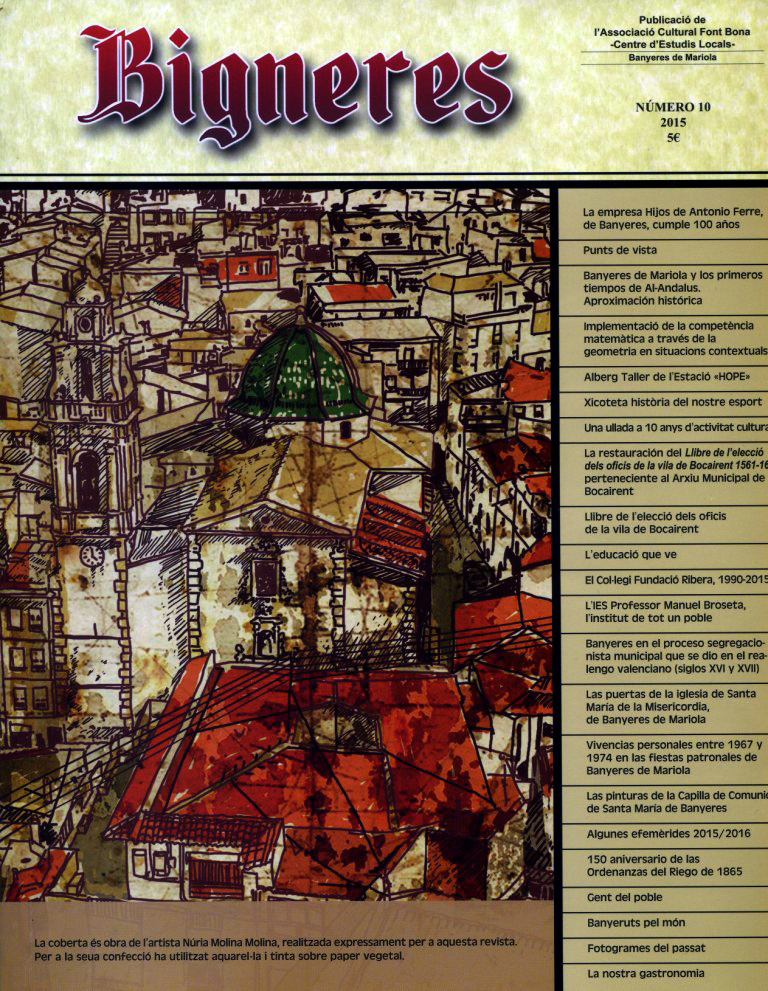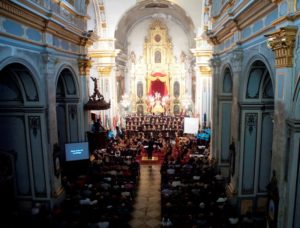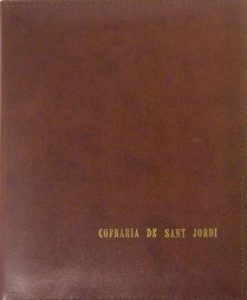
Mª Carmen Cortés Sempere, Diploma in Social Work and Graduate in Humanities
As the authors of “Banyeres” point out, Historical and geographical and cultural study of the Villa " 1, the statement of the notary Laureano Ballester, in the "Memorial of the Orders followed by the Town Council of the town of Biar against the Town Councils of the towns of Bocairente and Banyeres in the Court of Valencia of 1817", It is a compendium of the history of our town. From him we know that King James I, the 13 October 1249, sold to Jaufrido de Loaysa and Jacometa, his wife, the castles and villas of Banyeres and Serrella, and that he filed a lawsuit for the demarcation of terms with Bocairente to said king, from which followed the constitution of a dividing line in July 1261 which was approved by the monarch himself.
When Jaufrido de Loaysa and his wife died, the lordship and dominion of Banyeres and Serrella passed by succession to Arnaldo de Romaní, who sold them to Pedro Dartés on 12 of January of 1381, Y, later, the 26 November 1446, Jaime Dartés and his mother Damiata in turn sold him to Bocairente, who was interested in the use of Banyere waters. Once Bocairente was the owner of the manor, he destroyed and made Serrella unusable and tried to do the same with the acquired town., For this reason, a lawsuit was initiated in the Superior Court of the Kingdom and it was argued that it was an older town than Bocairente., just as it had an end, jurisdiction, ordinances and how many requirements a town could have, but it was not until 14 October 1628 that the segregation of Bocairente was achieved, granted by privilege of King Felipe IV 2.
During the period that Banyeres belonged to Bocairente it was called "lloch". the procession began in Valencia, "place", "lloch" in medieval Valencian language, It referred to the dependence that a manor had on a city or town.. So Banyeres, together with Alfafara, They were considered lordships of the town of Bocairente. Also Alfafara, in 1632, would achieve segregation.
Twenty years after its purchase, thanks to a privilege from King Juan II of Aragon in 1466, the agreement between the two was confirmed, and Banyeres was integrated into Bocairente as a street and village of the latter, forming an indissoluble territory, and its inhabitants were considered neighbors and inhabitants of the town of Bocairente. When John II died, Banyeres tried to separate itself from Bocairente on several occasions without success until achieving it on the date of 1628, as has been said.
The segregationist process that Banyeres began is included in a broader one that other local communities carried out., with different rhythms and modalities, during the 16th and 17th centuries. The desire for emancipation and becoming autonomous municipalities remained, in a way, latent until demographic evolution (Banyeres counted, in 1609, with a hundred neighbors or houses, quantity that corresponded to, approximately, 450 population) and economic was more favorable, which contributed to the desire for self-government and independence. But nevertheless, according to David Barnabas, it does not seem likely that until 1570 These wishes would lead to a legal formula that would allow the demands for municipal emancipation to be met without the need to grant the full independence that the privilege of villazgo entailed. 3.
The legal formula that responded to segregationist desires was the configuration of a new municipal category called "university.", which could only be obtained by privilege granted by the Crown. A) Yes, The oldest concession known was the one that obtained the place of Algemesí, which belonged to the town of Alcira. But the example was followed by other places and in just two decades more than ten university privileges were granted., among them that of Banyeres in 1628, which was one of the latest. Alfafara, who shared luck with Banyeres, I would still get it four years later 4.
Not all places that aspired to segregate achieved it, since the university privilege entailed a fairly high cash consideration in favor of the Crown, which could not always be paid, thereby frustrating their desire for independence.; thus the place of Catral, for example, just offered 2.500 pounds, and since the Crown demanded 4.000 in exchange for the privilege, In the end, the small neighborhood ended up renouncing its segregationist aspiration..
From the data available, it is known that the price paid for places to become universities ranged between 4.000 Y 8.000 pounds. Although we do not know what Alfafara paid, we do know the price that Banyeres paid., what was 4.000 pounds. The economic difficulties of the reign of Philip II encouraged the segregationist process in regional Valencia. The sale of university privileges enriched the Crown, so it was not sparing in granting them, despite the natural opposition displayed by the affected towns and cities 5.
University privileges responded to a general model that was applied to all segregated places, with the exception of Banyeres, how will we see. The first thing we highlight is the jurisdictional level that was granted, which was the same one that developed in the Alfonsino privilege of 1329, which granted full jurisdiction and low criminal jurisdiction to anyone who populated its domains with a minimum of settlers., fifteen if they were old Christians, In the case of Mudejars, three were enough if they were populated in royal terms., and seven if the domain was already under the jurisdiction of another lord 6. The Alfonsina jurisdiction preserved the high criminal jurisdiction for the town or city to which it had been belonging.. This indicates that a model was chosen in which segregation was not complete because, although the Interests of the parent municipality were harmed, they were still allowed to maintain a certain dominance 7.
With the acquisition of municipal rank, upon becoming universities, own governing bodies were created and magistrates were provided. The election procedures were regulated in the privilege. In addition to civil and criminal justice, three or four juries were created, according to the number of population: attorney, receiver, almotaxen, clavary, rent collectors and a nouncio of the juries. The justice, As was the case in the towns and cities, he could appoint his advisor and a lieutenant.. The powers of all of them were regulated in the jurisdictions. Two "councils" were created, a general and closed one formed by 25 The 30 members and another individual formed by 9 The 10 people. However, The system for electing municipal officials is imprecise and no specific procedure is referred to., so we assume that it was left to the discretion of the electoral bodies or to a negotiation with the Crown. There is no allusion to the insaculatory system that had already spread in the royal cities and towns. 8.
The case of Banyeres is different, perhaps due to the late nature of its segregation; The truth is that he was granted the privilege of insaculation, of which he already participated when he was "lloch". Bocairente 9, establishing three bags or sacks for the annual lottery of positions: a bag for the extraction of justice, with six people; another for the jury first with six names, and another for second and third jurors, with twelve names. Every three years, new people were insaculated if there had been any loss., to complete the quota; or to change bags, always proposed by the jury. Also here two "councils" were constituted: a private one made up of nine neighbors, appointed for the first time by the “battle” and the juries, and subsequently extracted by lottery from among those unsaculated in the three bags and from the nine mentioned components. Of these thirty-three people, the almotacén or “Mustaçaf” was also drawn., which was a profession of medieval origin 10. Its competencies covered three areas: urban planning, market surveillance and control of artisans 11. Acted against those people who committed fraud in weights and measures; He controlled every day the quality of the food products that were shipped in the city, touring the butcher shops with his subordinate, fishing, taverns, stores and any establishment selling merchandise, Y, He also monitored the urban aspects, cleaning, health of the streets and lighting thereof and exercised control over the different guilds of artisans.
There was also a general “consell”, open and the attendance of thirty neighbors was enough for it to hold sessions. Except in the composition of this "consell", In Banyeres, we are witnessing the configuration of a closed group capable of monopolizing the governing bodies and controlling the endogamy of power. 12.
Armando Alberola has studied the municipal organization in the provincial era and describes the insaculation procedure in the following way:
«It was about insaculation or “sac i sort” procedure, consisting of the extraction by lottery of the names of those who would occupy the different positions of the citizen government during the period of time established by the respective ordinances. The extraction was carried out from among a small number of candidates previously selected and whose names, registered on lists or “cedas”, They were placed in bags or “sachs” prepared for this purpose. 13.
Logically, how this system was based on class society, The representation of citizens was related to economic power and the influence that each of the classes had on their population.. further, This system favored the consolidation of oligarchies because inclusion in any of the exchanges was for life., and the power to include new members was conferred on those who were already in them; Since the highest-ranking positions were also reserved for those unsealed in the main stock, it follows that the system generated the consolidation of a small group of notables who held power.. This put local control on a plate to the Crown., since it was only enough for him to grant certain favors to this group in order to have control of the town or city..
He was John II of Aragon in 1459 who determined the creation of two bags, “Major Sach” and “Minor Sach”, in which they were introduced, after making a list, the names of the people who were considered suitable for holding positions of responsibility in the municipality. In the 17th century, Philip III expanded the number of bags to three., creating those of Knights, Citizens of the Greater Hand and Citizens of the Minor Hand.
A position of capital importance in the municipal organization chart was that of Notary, since it was his responsibility to control all the bureaucracy and matters related to the municipal organization, as well as the defense of the ordinances issued by the monarchs. This position was for life and royal appointment. As a public notary, he had to attend all official events and was also responsible for the correspondence that was maintained both with the Court and with the capital of the Valencian Kingdom.. recorded, Likewise, the Privileges and Royal Provisions and verified the registration of all those unsacculated in the different bags 14.
Regarding financial administration, the proposal for the university degree, was that every year those responsible for said administration, What were the juries?, to give an account when leaving office to the new jurors who entered, but the Crown not only did not consent to it but also reserved the power of royal supervision.. That is to say, initiated a policy of control of local estates, although curiously this reservation is not included in the privilege of Banyeres. The Crown also took advantage of the granting of university privileges to reduce the autonomy that the jurisdictions granted in the fiscal field., although Banyeres was not affected by this cut either.. The reinforcement of royal power in the granting of university privileges is also seen in the creation of the figure of the local “batle”, representative of the royal administration in the municipality.
Banyeres also benefited from other faculties that the Crown granted to universities., because the concession of having one market day a week, basic so that the community could supply itself, He also obtained royalties and monopolies: taverns, stores, ovens and counters, that until that moment the mother town operated, Bocairente. The Crown also granted the creation of a municipal grain warehouse to regulate the market and supply of wheat. 15.
The segregation obtained by the privilege of university did not entail, as seen, a total independence, Therefore, the emancipation movement that began did not stop with obtaining the municipal category of university., Y, despite the opposition that this movement aroused among the affected cities and towns, Some universities continued their independence struggle and managed to acquire the title of royal town a few years later.. A) Yes, seven universities and two places achieved the rank of villazgo during the reigns of Philip II, Felipe III y Felipe IV 16, Banyeres would get the Villa Real title, Faithful and Loyal later, in 1708, during the reign of Philip V. With this, it finally acquired the category of perfect municipality, being equipped with all the necessary requirements for it 17, to the present day.
NOTES:
1 VALERO DOMENECH, Romuald and another. "Bathtubs, Historical and geographical and cultural study of the Villa, Mariola bathtubs», 1986, p. 19.
2 Ibid, pp. 20-25.
3 BERNABE GIL, David: «Universities and Villas. Notes on the process of municipal segregation in the Valencian royal family (sixteenth and seventeenth centuries)». modern history magazine, N. 6 – 7 (1986-1987). University of Alicante, p. 14.
4 Ibid, p. 15.
5 Ibid, p. 16.
6 GIL OLCINA, Antonio: «Land ownership in the lordships of Alfonsina jurisdiction», Geographic investigations, n° 1, Alicante, 1983, pp. 7 – 27.
7 BERNABE GIL, David: «Universities and Villas. Notes on the process of municipal segregation in the Valencian royal family (sixteenth and seventeenth centuries)». modern history magazine, N. 6 – 7 (1986-1987). University of Alicante, p. 18.
8 Ibid, pp. 17-18.
9 VALERO DOMENECH, Romuald and another. "Bathtubs, Historical and geographical and cultural study of the Villa, Mariola bathtubs», 1986, on. cit, pp. 55-66.
10 In a job where he was a chronicler of the city, Vicente Martínez Morellá, «The book of orders and privileges of the Almotacén court of Valencia for observance in Alicante», Alicante, 1975 The existence of a "mustaçaf book" in the city was announced and that it was in a poor state of preservation.. The restoration center of the Valencian Community, Located in the Archive of the Kingdom of Valencia, it was restored and an edition of the aforementioned book was made., with the title "The book of Mustafaç of the city of Alicante", by the Department of Publications and Image of the Alicante City Council in the Historical Sources of Alicante collection, directed by Ma Jesús Paternina and Joan Vicente Hernández Mas, with an introductory study by Professor Mª Luisa Cabanes Catala in 1989.
11 In the cited edition, p. 29.
12 BERNABE GIL, David: «Universities and Villas. Notes on the process of municipal segregation in the Valencian royal family (sixteenth and seventeenth centuries)». modern history magazine, N. 6 – 7 (1986-1987). University of Alicante, on. cit., p. 18.
13 ROMAN ALBEROLA, Armando: «The organization of the municipality in the provincial era», in History of the city of Alicante in the Modern Age. Alicante, 1990, pp. 185-212.
14 The insaculatory system disappeared in 1708, after the War of Succession and the adaptation of the municipal model to the existing one in the Castilian municipalities.
15 BERNABE GIL, David: «Universities and Villas. Notes on the process of municipal segregation in the Valencian royal family (sixteenth and seventeenth centuries)». modern history magazine, N. 6 – 7 (1986-1987). University of Alicante, on. cit.„ pp. 19-20.
16 Ibid, p. 21.
17 BERNABE GIL, David: “Realengo and Señorío in the process of disintegration of the large Valencian municipalities. A comparative analysis (16th-17th centuries)”, Pedralbes: modern history magazine, N° 13, 1, 1993, p. 381
BIBLIOGRAPHY
– ROMAN ALBEROLA, ARMANDO: «The organization of the municipality in the provincial era», in History of the city of Alicante in the Modern Age. Alicante, 1990.
– BERNABE GIL, DAVID: «Universities and Villas. Notes on the process of municipal segregation in the Valencian royal family (sixteenth and seventeenth centuries)». modern history magazine, n°. 6-7 (1986-1987). University of Alicante.
– «Realengo and Señorío in the process of disintegration of the large Valencian municipalities. A comparative analysis (16th-17th centuries)», Pedralbes: modern history magazine, n° 13, 1, 1993.
– GIL OLCINA, ANTONIO: «Land ownership in the lordships of Alfonsina jurisdiction», Geographic investigations, n°1, Alicante, 1983.
– VALERO DOMENECH, ROMUALDO is the other. bathtubs, «Historical-Geographical and cultural study of the town, Mariola bathtubs», 1986.
ILLUSTRATIONS:
1 Fragment of the map of the ancient kingdom of Alicante. Font Joan Blaeu. Atlas Maior and 1665. Spain, Portugallia, Africa & America. Bagm, p. 90.
2 Map of the Sierra Mariola Natural Park where you can see the main town of Bocairente and the equidistance of the two dependent places in the provincial era of Banyeres and Alfafara.










